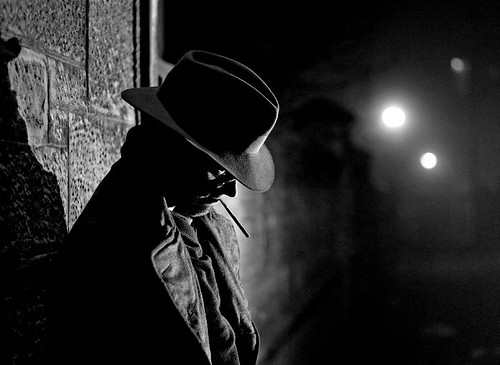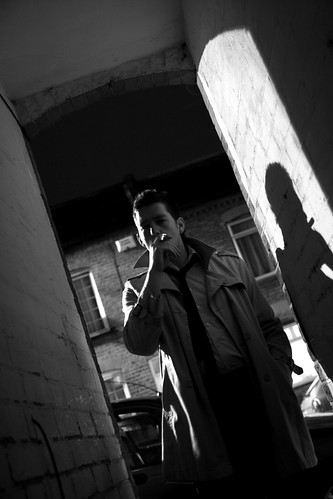The genre I have chosen to work in is Film Noir. This is because I have never worked in that field before, and doing so would be an exciting and beneficial challenge for me. It also appeals to me as a stylish genre, allowing me to work with camera techniques and lighting I haven't experienced before.
Film Noir was coined by French film critics who noticed the trend of how 'dark', downbeat and black the looks and themes were of many American crime and detective films released in France to theatres following the war. Fear, mistrust, bleakness, loss of innocence, despair and paranoia are readily evident in noir, reflecting the 'chilly' Cold War period when the threat of nuclear annihilation was ever-present. The criminal, violent, misogynistic, hard-boiled, or greedy perspectives of anti-heroes in film noir were a metaphoric symptom of society's evils, with a strong undercurrent of moral conflict, purposelessness and sense of injustice. There were rarely happy or optimistic endings in noirs. The primary moods of classic film noir were melancholy, alienation, bleakness, disillusionment, disenchantment, pessimism, ambiguity, moral corruption, evil, guilt, desperation and paranoia.
Typical camera shots:
Low angle shots - Makes a character look more important and authoritative
Dutch angles - creates atmosphere of disorientation and unease
Wide angle lenses
Ominous facial shots - emphasises alienation and misery the protagonist is feeling.
Shots through windows / glass / mirrors.
Visual style: Low key lighting, often from a single source. Produces stark dark/light contrasts and dramatic shadow patterning created by highlighting only parts of a subjects face, creating an air of mystery surrounding the chara Black and white cinematography is viewed as an essential attribute to "classic noir" though modern, or "neo-noir" films disregard this. Examples of neo-noir include Brick and Pulp Fiction.
Mise-en-scene: Usually associated with an urban setting (LA, New York etc). The cities are presented as a "maze" or "labyrinth". It is always set at night, with lighting coming from nearby buildings, or external lighting such as street lamps. Bars and night clubs are also popular choices for settings.
Sound: The sound of noir is plaintive sax solos, blue cocktail piano, the wail of a distant trumpet through dark, wet alleyways. This music sets the tone for a smooth, but dark film experience. Non-diagetic sound also includes voice-overs from the protagonist, giving us an insight into the mind of a morally corrupt character. Dialogue is sharp, quick and witty, with heavy use of innuendo.
Narrative: Typically, noir has unusually convoluted storylines, often including flashbacks and other editing techniques intended to obscure the narrative sequence. Another staple of the Film Noir genre is the voiceover, given by the protagonist as the film progresses. This allows us into the minds of the troubled individual, inviting the viewer to feel greater empathy for the character, and allowing them to get a clearer understanding of what's going on.
It will be hard to challenge the conventions of a film when you're trying to emulate it as best as possible, especially when you are getting marked for how well you replicate the genre. Especially as i am a very inexperienced film maker, i would be getting over my head in attempting anything radical or different yet. For those reasons, i will not be challenging any conventions, with my film trying to stay as pure to the genre as possible.


No comments:
Post a Comment